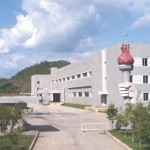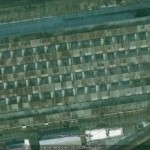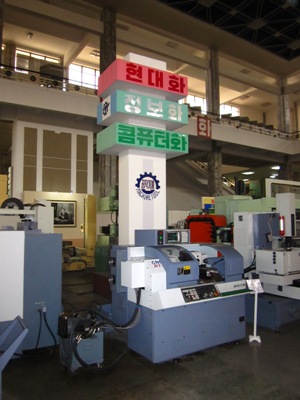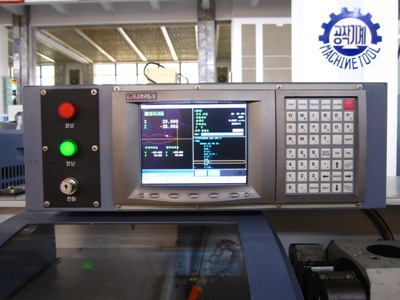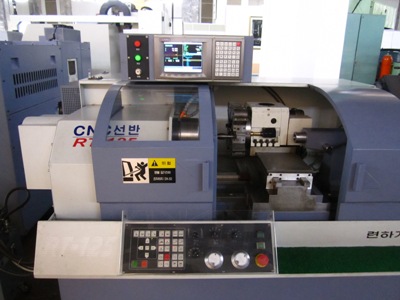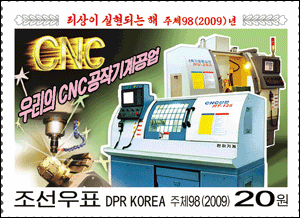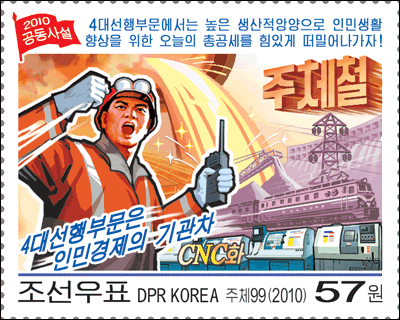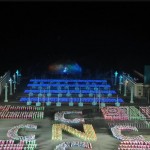KCNA
4/6/2002
Kim Yong Sun meets S. Korean delegation
Kim Yong Sun, chairman of the Korean Asia-Pacific Peace Committee, met a delegation that had attended a ceremony of commissioning the Pyonghwa Motors General Factory at the People’s Palace of Culture today and had a talk with it in an atmosphere overflowing with compatriotic feelings.
Setting Up Shop in N. Korea: Car Firm Plunges In
Los Angeles Times
Barbara Demick
3/28/2002
Company linked to Sun Myung Moon’s church is to open an assembly plant in April.
At first glance, there couldn’t be a more improbable business proposition than opening an automobile factory in North Korea, where hardly anybody owns a car or knows how to drive. Even more surprising is that the company making this investment is an affiliate of the Unification Church, headed by the thumpingly anti-communist Rev. Sun Myung Moon.
Against all odds, Pyonghwa Motors next month is opening a $55-million auto assembly plant where there once were rice paddies in the western coastal city of Nampo. It is one of the largest private ventures in North Korea, a bastion of militant communism that only recently has cracked open its doors to foreign investment in a desperate quest for hard currency.
“This country was so closed that nobody, not God, not Buddha, could get in the last 50 years without a visa,” Park Sang Kwon, the president of Pyonghwa Motors, said at a news conference Friday in Seoul, the South Korean capital, where the company is headquartered. “Nobody, even in my own company, believed it was possible to build an automobile in North Korea. Only I believed.” Initially, the assembly line will turn out Fiat Sienas, a compact model, but Pyonghwa Motors hopes to develop its own model for the North Koreans.
The communist government, which also owns a stake in the company, has contracted to buy 1,000 cars in the first year. After that, the company hopes to sell vehicles in China, Russia and, if the political situation allows, South Korea. The plant has the potential to turn out 20,000 cars a year.
The unlikely relationship between the Unification Church and North Korea dates to 1991, when Moon visited the country’s founder and chief ideologue, Kim Il Sung. That paved the way for Moon, an archconservative who nonetheless supports dialogue with the North, to buy two hotels in Pyongyang, the North Korean capital, including the 161-room Potonggang, which boasts of being the only hotel in the isolated country with satellite television.
The North Koreans also allowed Moon’s followers to develop Jongju, the northwestern town where Moon was born, into a pilgrimage site–another coup for the Unification Church because the communist nation bans all practice of religion.
In addition to the car assembly plant, Pyonghwa wants to open a department store, gas stations, automobile showrooms and what the company described as a “World Peace Center” in Pyongyang to promote cultural and educational exchanges.
Pyonghwa officials say they hope the investments will advance the reconciliation process between the two Koreas, estranged for more than half a century. Indeed, the name of the company means “peace” in Korean.
“We will show the North Koreans brotherly love through this project,” Park, the company president, said Friday, flashing slides for journalists of North and South Korean employees working together in building the assembly plant, then clowning around as they pose for a photograph.
From a financial viewpoint, the company hopes that low labor costs will allow it to turn out automobiles more cheaply than elsewhere in Asia. The company now employs about 200 North Korean auto workers who are paid an average of $120 a month.
“We are bound to succeed,” Park said. “There are no unions, low labor costs. The workers are very clever, very quick to learn, and they are harshly controlled by their superiors.”
Among the extraordinary problems that Pyonghwa has encountered in trying to do business in North Korea is the erratic power supply and poor transportation system. The new plant is situated next to a 2-year-old highway linking Nampo with Pyongyang, 25 miles to the northeast. However, the road was constructed with picks and shovels; it does not accommodate heavy trucks well and frequently needs repairs. Merely putting up a sign over the front gate of the factory was a struggle, in which capitalism ultimately triumphed over communism.
“This is the first time anybody was allowed to put a company logo on a billboard in North Korea,” Park said.
The plant’s grand opening, scheduled for April 5, comes as North Korea is going through a particularly rough patch in trying to attract foreign investment. The rapprochement with South Korea has ground to a halt, while President Bush’s characterization of North Korea as part of an “axis of evil” has hardly induced companies to invest.
There also have been a number of well-publicized failures. Hyundai, the South Korean conglomerate, recently had to turn to its own government for a bailout to rescue its 3-year-old venture bringing tourists to North Korea’s scenic Mt. Kumgang.
“We advise companies to look carefully, to cross-check everything as much as possible before doing business in North Korea,” said Jean-Jacques Grauhar, secretary-general of the European Chamber of Commerce in Seoul. “We don’t think the legal framework is satisfactory at this stage, and the general way of doing business is not yet developed.”
In addition to its assembly line, Pyonghwa is refurbishing used cars imported from Japan for resale in North Korea. That business opened early last year and has brought in about $300,000 in sales.
There are 3,000 passenger cars in North Korea for a population of 23 million. All are said to belong to the government or top officials.
Pyonghwa also owns a Fiat assembly plant in Vietnam and has tried various automotive projects in China, which so far have been unsuccessful.
The company’s affiliation with the Unification Church is unclear. Several businesspeople in Seoul said it is part of the church, although company officials said it is merely owned by individuals who are church members, including Park, who owns about 80%.
“This really has nothing to do with religion, and the fact that our president is a member of the church doesn’t affect the way the company does business,” said Lee Hyun Tak, a Pyonghwa official.
Unification Church to sell 1,000 cars in N.Korea in ’02
Reuters
Samuel Len
3/22/2002
The automotive arm of South Korea’s Unification Church said on Friday it has finished building a $55 million car assembly plant in famine-hit North Korea, whose government has pledged to buy 1,000 cars each year.
“North Korea wants to develop its own model as soon as possible,” Park Sang-kwon, the company’s president, told a news conference in Seoul.
Business prospects in the reclusive country seemed to glow shortly after President Kim Dae-jung of South Korea held an unprecedented summit in 2000 with North Korean leader Kim Jong-il.
But relations between the neighbours chilled last year and have come under even greater pressure after President George W. Bush labelled North Korea part of an “axis of evil” in January.
North and South Korea remain technically at war as the 1950-53 Korean War ended without a peace agreement.
Undaunted by this atmosphere, Pyeongwha Motors Corp, the first South Korean company to build an auto plant in the north, says it sees a burgeoning market.
Pyeongwha, which means “peace” in Korean, is a joint venture with North Korea’s Ryonbong company. The assembly plant in the port city of Nampo will be capable of rolling out up to 20,000 cars annually when it opens on April 5.
Two years ago, Pyongyang completed a spanking new, 10-lane highway linking the port city of Nampo to the capital, he said.
All that’s needed, Pyeongwha says, are cars to fill the empty roads of a country of 23 million people. However, there were just 3,000 passenger cars among the 290,000 to 300,000 vehicles in North Korea in 1999.
NORTH KOREAN CAR EXPORTS?
The Unification Church, founded in 1954 by Reverend Sun Myung Moon and famed for mass wedding ceremonies, is also a considerable business force in South Korea. Its interests range from refining titanium to pharmaceutical products.
“We were chosen because we approached them with an offer to develop our own offspring,” he said. “We want to fill North Korea with cars and then export them.”
Exports could begin anywhere from 10 to 15 years down the road, with North Koreans preferring to export an indigenous model fitted with a Pyeongwha engine, Park said.
The orders from the North Korean government alone would be enough for the company to break even. Ssales are expected to rise to 2,000 to 3,000 cars next year, he said.
The plant assembles one model for domestic sales, the Siena compact designed by Italy’s Fiat SpA FIA.MI.
Pyeongwha has imported used Japanese cars into North Korea and refurbished for resale using North Korea’s cheap labour. It has been selling 20 to 30 cars a month, at between $10,000 to $15,000, mainly to foreign businessmen and diplomats, Park said.
Park painted a picture of life in the North Korean capital far different from the horrific images of outer regions described by aid workers.
“There’s a nine-hole golf course in the city, as well as a driving range,” built by ethnic Koreans in Japan, Park said.
Wikipedia:
Stockholders
70% Pyonghwa Motors (Seoul) (owned by the Unification Church)
30% Ryonbong Corp.
Car models
Hwiparam (휘파람 – Whistle) – based on the Fiat Siena
Ppeokkugi (뻐꾸기 – Cuckoo) – based on the Fiat Doblò
Premio (also known as Cuckoo 3) – based on a Dandong Shuguang pick-up
Pronto (also known as Cuckoo 2) – based on a Dandong Shuguang SUV
Junma – apparently based on the SsangYong Chairman
Video from DPRK state television
